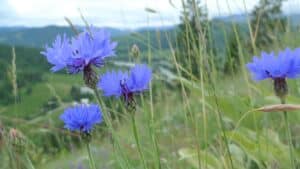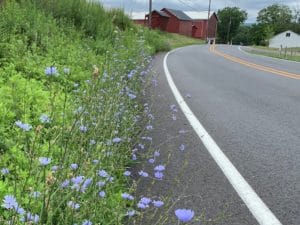Hello fellow readers; I recently discovered Bachelor Buttons are called Chicory and Chicory Bachelor Buttons, though they are look-alikes. Such fun to learn about these blue beauties’ origins, differences, and love stories. And there’s Chicory Fairy and poem, sure to delight.
Kate, in Sparta, NJ, shared. “My mom read me the poem when I was a kid, and I’ve always loved it.”

Common Chicory (Cichorium intybus)
By the white cart road, Dusty and dry, Look! There is Chicory, Blue as the sky! Or, where the footpath Goes through the corn, See her bright flowers, Each one newborn! Though they fade quickly, O, have no sorrow! There will be others Newborn tomorrow!
I couldn’t find the author or when written, but the charming illustration of a child fairy with wings sporting a Chicory bloom cap and skirt dancing on the leaves with a swath of the lovely blue blooms surrounding her has a vintage flair.
Chicory shares the name Bachelor Buttons.
As I dug further into Common Chicory (Cichorium intybus), I learned it shares the common name Bachelor Buttons, also known as Cornflower. Common Chicory is also known as Blue Daisy, Blue Dandelion, Blue Sailors, Blue Weed, Cornflower, Horseweed, and Ragged Sailors.
Are you confused? So was I, and why botanical names are essential in identifying plants.

Bachelor Buttons (Centaurea cyanus) Photo: Thayne Tuason, CC BY-SA 4.0 via Wikimedia Commons
Bachelor Buttons, Centaurea cyanus, is an old-fashioned flower that has beautified gardens for centuries, first in Europe. They grow well in full sun and are easy keepers.
Folklore of Bachelor Buttons (aka Cornflower)
As the folklore goes, young men in love wore Bachelor Buttons. If the flower faded too quickly, it was a sign that the man’s love was not received by his intended.
Like the reality show, there’s a new bachelor every year— an annual plant rather than a perennial. Bachelor Buttons self-seed vigorously and grow 16 to 35 inches tall with grey-green branches. The flowers are about an inch and a half and intense blue. In the past, he often self-seeded in crop fields, hence the name Cornflower.
 Cornflower – Endangered or Invasive?
Cornflower – Endangered or Invasive?
In Europe, the Cornflower is now endangered primarily due to the overuse of herbicides destroying its native habitat. Plantlife conservation organization named him one of 101 species to “bring back from the brink.”
On the other hand, after introduction as an ornamental plant in gardens, Bachelor Buttons have naturalized in many parts of the world. He’s now found wild in every state except Alaska and is considered weedy or invasive by some authorities. But they also attract beneficial insects such as ladybugs, lacewings, ground beetles, and other insects that feed on pests and pollinate crops, increasing yields.
Bachelor Buttons vs. Chicory Look-alikes
There are similarities between the two plants called Bachelor Buttons. Both are in blue hues and are from the same Asteraceae family (as are aster, daisies, dandelions, and sunflowers). And both are edible.
But the Cornflower (I always called Bachelor Buttons) is brighter blue with flat petals outside and furrowed petals in the center. In contrast, the Chicory flower only has two rows of flat petals.
And as it turns out, you’re more likely to see Chicory on the sides of the roads as they are considered an invasive species in the United States. Nevertheless, she, too, comes with a love story.
The love story of Chicory
Every morning a young maiden with beautiful blue eyes would walk out to the spot by the road where she said goodbye to her love when he went off to war. Days turned into years, and he never returned. Overcome with sadness, she crumbled to the ground on that same spot by the road, destined to forever wait for her love as a beautiful blue flower.
Back to The Chicory Fairy poem—I adore how it summarizes the cycles of nature that are never ending and the hope that exists because of it. Though they fade quickly, O, have no sorrow! There will be others Newborn tomorrow!
Garden Dilemmas? AskMaryStone@gmail.com and your favorite Podcast App.
There’s more to the story in the Garden Dilemmas Podcast:
Link to more about The Chicory Fairy



Hi Mary,
I came across your blog seeking to understand the difference between cornflower, chicory, and bachelor’s buttons. Through this article I learned all that & more
Thank you so much for “being”
I am designing a little seed library in conjunction with a solar power demonstrator .. thinking like the little free libraries we have hear but with solar on the roof. I also would like to use a QR code to provide links to blogs that I think will help educate on plants, renewable energy, sustainable practices, etc. I am in the process of curating suitable weblogs and websites. While I am primarily seeking content & Authors specific to SW Ontario, Canada, your articles offer culturally significant details that I haven’t seen before. It’s also beautifully laid out
Thanks for your contributions to the world
Ruth
Steeltown Solar, Hamilton Ontario, Canada
Hi Ruth, Your project sounds fascinating! Feel free to share my blog. Thank you for your kind words, Mary